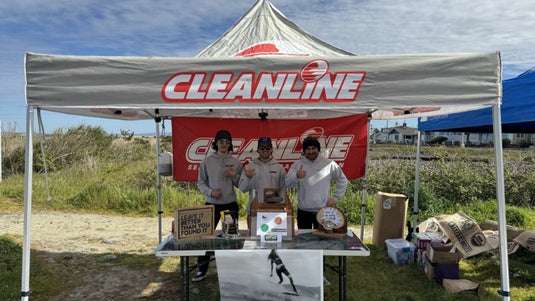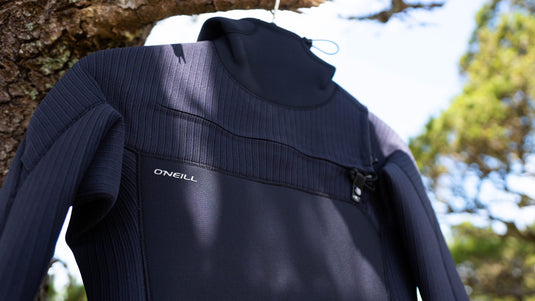Wetsuit Care Guide: Cleaning, Maintaining and Repairing Your Wetsuit

There’s nothing like the feeling of a brand-new wetsuit and nothing can ruin a session more than a hole-y, freezing cold suit. Taking care of your wetsuit and other neoprene accessories is well worth it for the added longevity of your gear. Wetsuit technology has come a long way in the past 20 years but the materials that wetsuits are made of are still susceptible to aging and damage. For that reason, we’ve gone ahead and created this comprehensive guide to go over proper wetsuit care, maintenance, cleaning, and if need be, repair.
Cleaning Your Wetsuit
Cleaning is the first line of preventative maintenance for any piece of rubber and proper cleaning will pay dividends over the years. Most surfers know that you need to clean your suit but many don’t know how to clean and dry your suit. After 40+ years of selling wetsuits and just as many renting and cleaning them, we know a few things about wetsuit care. Here are the essential steps for cleaning your wetsuit
STEP 1: After use, always wash your suit out with freshwater. A garden hose, tub of water, shower, or heck even a creek works. (If you do take it in the shower be sure not to use hot water). Saltwater is tough on everything including wetsuits, so washing your wetsuit off as soon as you’re out of the water will minimize the long-term wear and tear of the ocean.
STEP 2: Clean your suit with wetsuit shampoo and an odor eliminator. This step is optional but recommended. If you want to truly clean your suit, we recommend picking up two cleaning products, wetsuit shampoo, and an odor eliminator. You don’t have to use these products after every use, but they’re good to have and use when you can. Shampoo and Mirazyme is an odor eliminator that kills all the microbial odors that get trapped in your gear. It even can mask the stank from your booties which are always, by far the worst smelling wetsuit accessory.
After rinsing the suit out in freshwater you can wash your wetsuit with wetsuit shampoo which cleans any algae, bacteria, and salt deposits from the rubber. Mix the shampoo and water in proportion with the amounts listed on the label and you’re good to go. If you use a wetsuit changing tote or bucket in your car to store your wet gear, just fill it up with water and you’re ready to wash
The last step in cleaning a wetsuit is to use an odor eliminator also called mirazyme or Pau Pilau to get rid of the downright nasty smells a wetsuit can develop. It’s important that this is the last step before drying, because in order for it to properly work it needs to dry on the suit. At the shop, we call this stuff liquid gold, because it works incredible and also costs a pretty penny so with that being said, less is more with this stuff and a little bit goes a long way.

STEP 3: Dry your wetsuit. The key to drying is to leave the suit inside out and dry it outside, out of direct sunlight. Throwing your suit out on your driveway or a parking lot will be the fastest way to dry it out but you’ll be surprised how quickly that direct sunlight will age the rubber. It’s best to hang your suit from a wetsuit hanger, NOT a regular hanger or clothesline as those put too much stress on a small surface area of the wetsuit and stretch out certain areas. Once the inside of the suit is dry to the touch (check at the wrist and ankles cuffs) you can flip it right-side out and wait until it’s fully dry.
Following these steps will pay off huge in the long run as your wetsuit will last longer and feel great. However, there are a few other maintenance tips that can further extend the longevity of your rubber.
Maintenance Tips
There are a lot of maintenance tips for keeping your wetsuit feeling and working great but these are the biggest ones that we see.
Storage - Don’t leave your wetsuit wadded up in the trunk of your car for days after use. Hang it out to dry. Leaving your wetsuit wet and balled up somewhere not only isn’t ideal it’s also kinda gross. For hanging, we recommend picking up a wetsuit hanger and sloping the suit over at the torso. This put little to no stress on the suit while it’s drying.

Entry and Exit Technique - When putting on or taking off a wetsuit, be sure to pull with your fingertips NOT your nails. This is more of a beginner tip, but we see countless new suits every year that are damaged by people pulling on their rubber (especially smooth skin sections) with their fingernails. Also take your time getting and out of a suit, the more evenly and consistently you put on or remove a wetsuit, the longer it should last. Also, pay attention to your zippers, and don’t yank ‘em too hard.
Pay Attention to your Surroundings - It’s smart to watch where you put a suit on or off. Getting into a suit in a rough parking lot with trash, broken glass, etc. is a quick way to damage your suit.
Warranty and DIY Repair
This is where things really get interesting. Before we go into repair materials and techniques it’s super important to bring up the fact that every wetsuit we sell carries at least a 1-year warranty on manufacturer’s defects. Some (Patagonia, Rip Curl) brands are longer so it’s well worth it to check a brand’s warranty policy before attempting a repair.
The reason being is that any home repair will void your warranty. If you have any chance at all of using your warranty, you should take it. We see this mistake all too commonly, so save yourself the cash and hassle and have a professional warranty service person fix your suit if possible.
That being said, there are definitely situations where a home repair is the best option. Suits that are older and outside of any warranty coverage can be given a second life with some basic repair materials. We recommend using the following for any repairs when your suit is out of warranty:

Aquaseal - This urethane repair adhesive comes out of a toothpaste-style tube and works wonders on fixing leaks, tears, and cuts. Much stronger and generally easier to work with than wetsuit cement, Aquaseal is a must-have. This stuff was designed for wetsuits but has a lot of different applications and can even work with synthetic fabrics like a GORE-Tex rain jacket.
Simply apply a thin layer with a popsicle stick or plastic knife and let it dry overnight. We recommend using a few layers especially if it’s a deeper cut or tear. If you’re trying to patch a hole you can use clear packing tape as a backer on one side and work out from that. Meaning, once the outside area has dried, you can remove the packing tape and apply aqua seal to that side as well. Otherwise, we’d recommend something more heavy-duty for anything larger than a dime.
Iron-On - Also known as Iron Mend, this is the kit you need to make a heavy-duty repair simple. If you’ve ever ironed on a patch onto a shirt, this stuff works in the same way. If you haven’t, it’s easier than it sounds. All you need is a clothing iron and you’re good to go. If you have a tear or wide hold through the wetsuit or an area that’s simply thinning, we highly recommend picking up some Iron-On.
Dental Floss/Fishing Line - This is the last resort option but if you have a suit that is ripping at the seam, you can McGuyver it back to life by sewing the two panels together using fishing line. If you have the patience, you could double stitch it and then apply layers of aqua seal over the stitching, followed by an Iron-On patch.
Final Thoughts
Hopefully, this was able to answer any questions you may have had about the proper care and maintenance of your wetsuit. If you have any questions, feel free to leave a comment, email support@cleanlinesurf.com or call us at 1-888-546-6176.
SHOP OUR ENTIRE SELECTION OF WETSUIT CARE PRODUCTS


















What Our Customers Are Saying